Securin is required for chromosomal stability in human cells
a chromosomal stability and securin technology, applied in artificial cell constructs, biochemistry apparatus and processes, instruments, etc., can solve the problems of preventing the evaluation of chromosome loss rates in proliferation, affecting the evaluation of chromosome loss rates, and affecting the stability of chromosomes
- Summary
- Abstract
- Description
- Claims
- Application Information
AI Technical Summary
Benefits of technology
Problems solved by technology
Method used
Image
Examples
example 1
Generation of Human Cells Lacking hSecurin
[0053]To evaluate hSecurin function, both copies of the hSecurin gene were inactivated via homologous recombination in HCT116 cells. HCT116 is a well-characterized human colorectal cancer cell line that has a stable karyotype and intact DNA damage and mitotic spindle checkpoints (Lengauer et al., 1997; Bunz et al., 1998). To obtain targeted deletions, vectors containing 5′ and 3′ elements derived from the hSecurin locus and an antibiotic resistance marker flanked by loxP sites (FIG. 1A) were transfected into HCT116 cells, and the resulting antibiotic-resistant clones were screened for proper integration as described in Experimental Procedures. Successfully targeted hSecurin+ / − heterozygotes were transfected with a Cre recombinase plasmid to excise the antibiotic resistance marker and then re-transfected with the original targeting vectors to disrupt the remaining wild-type allele.
[0054]Genomic PCR analysis with two different sets of primers ...
example 2
Chromosomal Instability in hSecurin-Deficient Cells
[0056]To examine whether securin deficiency altered the rate of chromosome loss, hSecurin− / − cells (KO1 and KO2) and isogenic control cells (HCT116) were passaged for 20 generations and analyzed by fluorescent in situ hybridization (FISH) using chromosome-specific centromeric probes. As shown in FIG. 2, two fluorescent signals per autosomal chromosome per nucleus were observed in parental cells (FIG. 2A). The fraction of cells with signals more or less than the modal value of 2, which is a quantitative index of CIN (Lengauer et al., 1997), was typically 1–4% (FIG. 2F, 2G). In contrast, 17% to 32% of the hSecurin− / − cells exhibited aberrant numbers of signals per nucleus (FIG. 2F, 2G; examples in FIGS. 2B–D).
[0057]To confirm and extend these analyses, we employed multiplex-FISH (M-FISH) to paint entire metaphase spreads and inspect chromosomes for abnormalities of structure as well as number. M-FISH analysis was restricted to near-di...
example 3
hSecurin− / − Cells are Defective in the Execution of Anaphase
[0059]We first attempted to determine whether hSecurin loss resulted in chromatid separation in the presence of spindle poisons, as observed in yeast cells with Pds1 deficiency (Yamamoto et al., 1996b). Parental and hSecurin− / − cells were treated with nocodazole or colcemid and examined at various times thereafter by Hoechst dye staining as well as by FISH using centromeric probes. No evidence of sister chromatid separation was observed, even after 24 hours of nocodazole or colcemid treatment (e.g., FIG. 3A).
[0060]To examine normal mitotic processes in more detail, we expressed the histone H2B-GFP fusion protein (Kanda et al., 1998) in parental and hSecurin− / − cells. We were thereby able to monitor nuclear dynamics in vivo. Passage through mitosis is characterized by a series of visually dramatic cytological events, including rounding up of cell bodies, condensation of chromatin, dissolution of the nuclear membrane, alignme...
PUM
 Login to View More
Login to View More Abstract
Description
Claims
Application Information
 Login to View More
Login to View More - R&D
- Intellectual Property
- Life Sciences
- Materials
- Tech Scout
- Unparalleled Data Quality
- Higher Quality Content
- 60% Fewer Hallucinations
Browse by: Latest US Patents, China's latest patents, Technical Efficacy Thesaurus, Application Domain, Technology Topic, Popular Technical Reports.
© 2025 PatSnap. All rights reserved.Legal|Privacy policy|Modern Slavery Act Transparency Statement|Sitemap|About US| Contact US: help@patsnap.com



